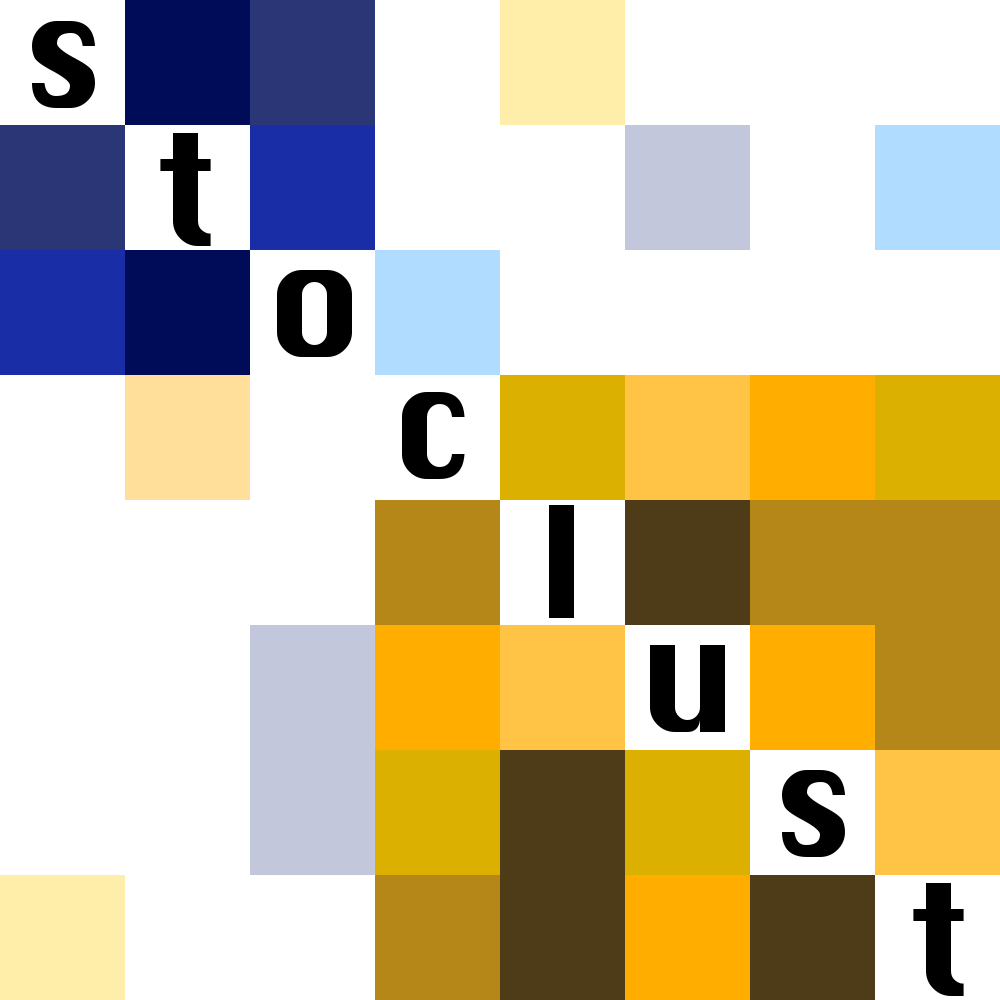stoclust

Clustering algorithms using stochastic analysis and ensemble techniques.
shi_malik
↳ clusteringshi_malik(st_mat, eig_thresh=0.95, tol=0, index=None)
Given a square column-stochastic matrix (that is, one with np.sum(st_mat,axis=1)=[1 ... 1]) describing the strength
of the relationship between pairs of items,
determines an Aggregation of the items using
the spectral approach of Shi and Malik.
A column-stochastic matrix \(\mathbf{T}\) will always have a leading eigenvalue of 1 and a leading uniform right-eigenvector, \(\mathbf{u}=(1,...,1)\), which is a fixed point of the map:
\[\sum_{j}T_{ij} u_j = u_i\]If \(\mathbf{T}\) has no disconnected components then u is the unique fixed point (up to a constant scaling) and the sub-leading eigenvalue is strictly less than one; otherwise, the eigenvalue 1 is degenerate. In the first case, if the sub-leading eigenvalue is close to 1, then the sub-leading right-eigenvector \(\mathbf{y}\) may be used to partition the indices into two slowly-decaying communities.
The Shi-Malik algorithm is recursive, taking the sub-leading eigenvector of \(\mathbf{T}\) (as long as the corresponding eigenvalue is above a threshold), using it to bipartition the indices, and then repeating these steps on the partitions with a reweighted matrix. This implementation cuts the vector \(\mathbf{T}\) by value, by default into components \(y_i>0\) and \(y_i<=0\), because of the orthogonality relationship
\[\left<\mathbf{y}\right>_{\pi} = \sum_i y_i \pi_i = 0\]which indicates that the mean value of \(\mathbf{y}\) under the stationary distribution \(\pi\)(left-eigenvector of \(\mathbf{T}\)) must always be zero, making this a value of significance.
The algorithm halts when no community has a sub-leading
eigenvector above the threshold, and the final partitioning
is returned as an Aggregation.
Arguments
| Arguments | Type | Description | |
|---|---|---|---|
st_mat |
np.ndarray |
A square column-stochastic matrix describing a Markov dynamic. | |
eig_thresh |
Keyword | float |
The smallest value the subleading eigenvalue may have to continue the recursion. |
cut |
Keyword | float |
The value used to “cut” the subleading eigenvector into two clusters. |
index |
Keyword | Index |
The Index which labels the indices of st_mat, and which will be the item set of the returned Aggregation. |
Example
First we will generate a sample dataset with two touching circles:
import stoclust.visualization as viz
import stoclust as sc
import numpy as np
import pandas as pd
n = 500
samples = np.concatenate([
sc.examples.gen_disk(num_samples=n,rad1=0,rad2=1),
sc.examples.gen_disk(num_samples=n,rad1=0,rad2=1)+
np.array([2,0])
])
agg = sc.Aggregation(
pd.Index(np.arange(samples.shape[0])),
pd.Index(['Left','Right']),
{
0:np.arange(0,n),
1:np.arange(n,2*n)
}
)Next, we apply the Shi-Malik algorithm
with eig_thresh = 0.98. This results
in a crisp division into two circles.
dist = sc.distance.euclid(samples)
T = sc.utils.stoch(
np.exp(-dist/0.05) - np.eye(dist.shape[0])
)
new_agg = clust.shi_malik(T,eig_thresh=0.98)
fig = viz.scatter2D(
samples[:,0],samples[:,1],
agg=new_agg, mode='markers',
text=new_agg.items.elements.astype(str),
hoverinfo='text,name',
layout = {
'margin':dict(l=10, r=10, t=10, b=10)
}
)
fig.show()However, note that lowering the threshold
even a little to 0.95 results in the appearance
of spurious sub-clusters:
dist = sc.distance.euclid(samples)
T = sc.utils.stoch(
np.exp(-dist/0.05) - np.eye(dist.shape[0])
)
# Note the new value of eig_thresh!
new_agg = clust.shi_malik(T,eig_thresh=0.95)
fig = viz.scatter2D(
samples[:,0],samples[:,1],
agg=new_agg, mode='markers',
text=new_agg.items.elements.astype(str),
hoverinfo='text,name',
layout = {
'margin':dict(l=10, r=10, t=10, b=10)
}
)
fig.show()Reference
Jianbo Shi and J. Malik, “Normalized cuts and image segmentation,” in IEEE Transactions on Pattern Analysis and Machine Intelligence, vol. 22, no. 8, pp. 888-905, Aug. 2000, doi: 10.1109/34.868688.